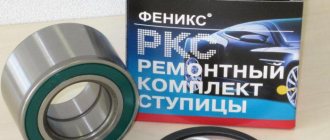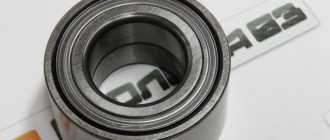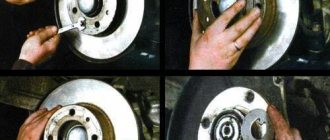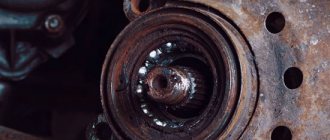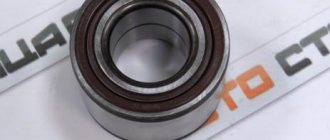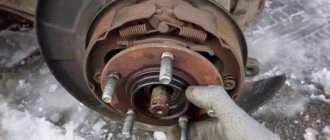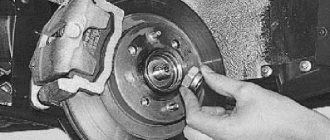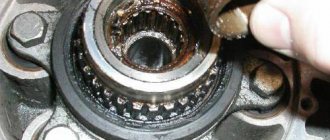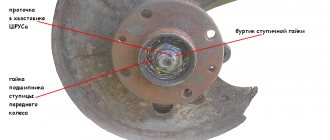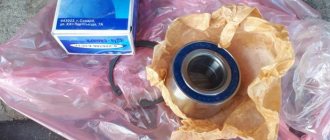In the previously published article “It’s time to replace the rear axle bearing or...”, a way to eliminate knocking in the rear axle axle in VAZ 2101, VAZ 2105, VAZ 2106, VAZ 2107 was considered, and it also said, I quote: “I would like to note right away that independently you can remove or change the axle shaft, as well as eliminate the bearing play in the seat. But replacing the bearing itself requires special tools and certain skills.” To this we can add that in all repair and maintenance manuals for the VAZ 2101 car and their modifications you will not be able to find a detailed description of how to replace the axle bearing with your own hands. Instead of instructions in these manuals, you will only find recommendations, such as: “replacing the axle bearing must be carried out at a specialized service station” or “replacing the lock ring and bearing on your own is not recommended.” And, of course, all this is true. But if you are on this site and reading these lines, it means that you have a great desire to carry out repairs on your own. And this article will be not only useful for you, but also necessary. Since the whole process of replacing an axle bearing is quite complex and time-consuming, and it won’t be possible to cope with it “quickly”! I would really like to know if you decided to repair the axle shaft after reading the article or left this work to specialists.
I will not describe in detail the process of removing the wheel, drum and axle shaft in this article (you can get information on this topic by clicking on the link). In short, just the important points:
Release the handbrake cable (necessary to facilitate removal of the brake drum). The brake drum itself can “stick” to the axle shaft and can be knocked down using a wooden attachment (see photo 1). Precisely wooden, since using a metal attachment can damage the brake drum. If there is no impact puller, you can pull out the axle shaft using the removed wheel. We screw the back side of the wheel to the axle shaft (two bolts will be enough) and knock out the axle shaft with sharp blows. In photographs 2 and 3 you can see examples of a “dead” bearing and axle shaft seal. Next, we collect the necessary tools and equipment to replace the bearing.
1. Hammer, chisel and it’s very good if you have an angle grinder. 2. Metal pipe with an internal diameter of 32 mm and a length of at least 80 cm. 3. Socket head at “32”. 4. 50-100 grams of engine or transmission oil, “working off” is also suitable. Litol-24 will also come in handy. 5. Gas or gasoline burner, in general, we think of a fire source on which you will have to heat the locking ring. There is no way to do without the fifth point, since the locking ring is pressed onto the axle shaft only after heating.
Remove the locking ring and bearing:
Using a chisel, cut the locking ring (photo 4) or, if you have a grinder, cut off part of the ring (photo 5). It is advisable to cut the ring, as shown in the photo. And the axle shaft will remain intact and the weakened ring can be easily knocked off. When the locking ring is removed, you can try to remove the bearing, the method is shown in photo 6. If you don’t succeed in knocking down the bearing, you will have to pick up the grinder again and use it to remove the bearing (don’t forget about safety glasses). After removing the bearing, remove traces of dirt and oil from the axle shaft. Install the bearing and locking ring:
Signs of a faulty VAZ 2107 axle bearing
When operating the vehicle, the axle bearing itself may wear out or its seat may break. Any bearing malfunction is easily determined by a number of signs:
- the buzzing of the rear axle increasing with speed, which can turn into a creaking or crackling sound;
- rear wheel play (you can check it by jacking up the car and rocking the wheel with your hands);
- loss of balls when the separator is destroyed (in this case, the axle shaft may move out of its seat while moving);
- jamming of the rear axle when the wheels stop rotating (if a wheel jams at speed, this can cause a serious accident).
The design of the bearing allows for a long mileage of the part, but material defects or excessive loads while driving on bad roads can lead to rapid wear of the unit. In this case, it is necessary to replace the VAZ 2107 axle bearing.
Bearing Failure Determination
Some recommendations will help you make sure that you need to replace the wheel bearing on your VAZ 2107:
- The easiest way to determine the need to replace the hub unit is to grab the front wheel and wiggle it in different planes. If you feel the presence of play, then it’s time for a more detailed diagnosis and most likely replacing the bearings.
- The front wheels of the car should be hung on a jack, while being sure to take precautions: pull the handbrake, install shoes and additional stands under the car. Grasp the top and bottom of the front wheel with your hands and then make movements. It is important to wobble the wheel, and not the car as a whole. Thus, you can accurately determine whether the product in question needs to be replaced.
- Another way to determine the need for replacement is to listen for humming, knocking, and grinding noises in the wheel as it rotates.
Replacing the VAZ 2107 axle bearing
To carry out the work, there is no need to lift the car on a lift or drive it into a viewing hole. Replacing a VAZ 2107 axle shaft or bearing is performed as follows:
- jack up, unscrew and remove the rear wheel;
- remove the brake drum;
- remove the brake pads using pliers to remove the springs;
- using a 17mm socket wrench, unscrew the axle shaft;
- remove the axle shaft from the seat (for this you need to use a wrench, inserting it between the rear part of the axle shaft and the brake cylinder and using it as a lever);
- remove the old axle bearing;
Front wheel bearings for VAZ 2107 sizes.
The table shows the dimensions for the front wheel bearings of a VAZ classic car.
| Installation location | Bearing type | Size, mm | Quantity |
| Front wheel hub (outer support) | Roller, conical, single row | 19,5*45,3*15,5 | 2 |
| Front wheel hub (inner support) | Roller, conical, single row | 26*57,2*17,5 | 2 |
Useful tips for replacing the VAZ 2107 axle bearing
When repairing a VAZ 2107 axle shaft, you must adhere to the following tips and rules:
To avoid damaging the axle shaft when cutting off the old bearing with a grinder, it is necessary to saw only the outer ring and the cage. It is enough to make several cuts on the inner ring, and then split it with chisels.
The new bearing is driven onto the axle shaft using a hammer. If you hit the bearing directly, there is a possibility of it being distorted or destroyed. Therefore, the bearing must be filled using a piece of pipe whose internal diameter is slightly larger than the diameter of the axle shaft.
It is unacceptable to heat the bearing before seating it on the axle shaft. A heated bearing enlarges and fits into place more easily, but this may result in “annealing” of the metal, worsening its physical properties. As a result of annealing, the ductility of the metal increases and the hardness of the metal decreases.
Replacing a VAZ 2107 axle bearing is a rather complicated task, but quite doable in a garage. The main thing is not to damage the surface of the axle shaft when removing and installing the bearing. When installing a new bearing, be careful when using a hammer, as the steel from which the bearing parts are made is very brittle. Otherwise, the procedure does not contain complex operations that require special qualifications and equipment.
The problem that will be discussed today is quite common on VAZ 2107 cars. This is the failure of the axle bearing. Replacing it at a car service center is very expensive, but it is possible to carry out this procedure yourself. We will talk about how to do this correctly in this article.
When should you replace a wheel bearing?
When will it start to hum, but the whole point is that it is very difficult to determine when you drive a car all the time, because the bearing will start to hum strongly only when it has actually all broken down and become unusable, so checking this way is not an option, for more For an accurate check, you will first need to hang the wheel (First the right front, then the left, it doesn’t matter, both wheels need to be checked) and after that, turn it by hand, it should spin without any jamming and hum (extraneous sound), there should be no (Only the pads can touch the brake disc, but this sound will be completely different, you can distinguish how the bearing hums and how the pads rub), for more details on how to check it, see the video below, it will be said about this hum, and more about how to determine by rocking whether the bearing has become unusable or not yet.
Purpose of the rear axle bearing
The axle shaft is the most important part of the drive (in this case, rear) axle of the VAZ 2107. The axle shaft itself rarely fails, but the bearing in which it is attached is the weak point of this design . The purpose of the part is simple: to ensure smooth and uniform rotation of the axle shaft in the rear axle while the car is moving. This part is located inside the bridge, immediately behind the brake drum. To see and change it, you will have to remove the axle shaft, remove the drum and brake pads from it. It is impossible to get to the bearing in any other way.
VAZ 2107 axle shaft bearing with retaining ring
Bearing Directory
home
When there was a shortage of auto parts for foreign cars, auto specialists looked for a replacement among similar products only from a Russian manufacturer.
They do the same today, because... The cost of imported bearings and seals is very high. It also happens that you have to wait a long time for this part, and even then more than a month. Or even the car was discontinued from production altogether. This is where the Russian spare part comes in – the bearing. In this table I want to show the bearing sizes. This directory will help you find the right analogue for your size. Follow one rule when selecting a bearing - the quality of our bearing must match the quality of a foreign one. Otherwise you will have to change the bearing every month.
| SEALS | ||||
| Dimensions, mm | Applicability, make, model of machine | Installation location | ||
| 16 | 8 | 7 | M. "Karpaty", "Delta" | Clutch lever |
| 25,1 | 12 | 7 | M. "Ural" | Pedal and gearshift lever |
| 26 | 13 | 8 | ZIL-4314 | Steering shaft |
| 30 | 15 | 7 | M. "Ural", "Dnepr" | Camshaft |
| 35 | 15 | 7 | M. "Karpaty", "Delta" | Crankshaft |
| 30 | 16 | 7 | VAZ-2108, "Oka" | Gear selector rod |
| 30 | 16 | 7 | M. "Dnepr" | Gearbox shift pedal |
| 30 | 17 | 7,5 | M. IZH-P, IZH-Yu | Crankshaft right |
| 47 | 17 | 10 | M. "Voskhod" | Crankshaft right |
| 34,8 | 18 | 9 | Outboard motor "Neptune" | — |
| 40 | 18,5 | 8 | "Oka" | Gearbox input shaft |
| 35 | 19 | 7 | M. "Minsk" | Wheel hubs |
| 37 | 19,3 | 10 | VAZ-2101…-2107.-2121 | Steering shaft |
| 32 | 20 | 6 | M. "Voskhod" | Kickstarter shaft |
| 32 | 20 | 7 | "Gazelle" | Steering shaft |
| 30 | 20 | 8,5 | M. "Dnepr" | Kickstarter shaft |
| 35 | 20 | 10 | "Volga", GAZ-3307 | Steering shaft |
| 40 | 20 | 10 | M. "Ural" | Kickstarter shaft |
| Motorized stroller SZD | Right crankshaft and fan | |||
| 32 | 21 | 7 | M. "Karpaty", "Delta" | Gearbox secondary shaft |
| 34,5 | 22 | 6 | KamAZ | Angular gearbox RU |
| ZIL | Screw RU | |||
| UAZ | Worm shaft | |||
| 35 | 23 | 6 | ZAZ, LuAZ, Moskvich-412 | Steering shaft, bipod shaft |
| 36,5 | 23 | 6,5 | M. IZH-P, IZH-Yu | Wheel hubs, kickstarter shaft IZH-P |
| 40 | 24 | 7 | "Tavria" | Gearbox input shaft |
| 42 | 24 | 7 | AZLK-2141 | Gearbox input shaft |
| 45 | 24 | 10 | ZAZ, LuAZ | Gearbox input shaft |
| 46 | 24 | 11 | ZIL-4314, KamAZ | Power steering pump |
| 46 | 24 | 13,5 | ZIL-4314 | Compressor |
| 38 | 25 | 8 | M. "Ural", "Dnepr" | Wheel hubs |
| 42 | 25 | 10 | LuAZ | Half shafts |
| M. “Tula”, “Ant” | Wheel hubs | |||
| 45 | 25 | 8 | VAZ-2108 | Gearbox input shaft |
| 52 | 25 | 6,5 | M. IZH-Yu | Intermediate crankshaft |
| 52 | 25 | 10 | M. IZH-Yu | Left crankshaft |
| 52 | 25 | 20 | M. IZH-P | Left crankshaft |
| 62 | 25 | 8 | M. YAVA-638 | Left crankshaft |
| 38 | 26 | 7 | ZAZ-968 | Half shaft |
| 47 | 26 | 10 | M. "Voskhod" | Wheel hubs |
| 40,25 | 27 | 7 | M. "Voskhod" | Gearbox secondary shaft |
| 42 | 28 | 7 | VAZ-2108, "0ka" | Front crankshaft; camshaft |
| 47 | 28 | 8 | VAZ-2101…-2107,-2121 | Gearbox input shaft |
| 43 | 28,6 | 10 | VAZ-2101…-2107.-2121 | Bipod shaft |
| 45 | 30 | 8 | VAZ-2101…-2107,-2121 | Rear axle shaft |
| 45 | 30 | 7 | "Tavria" | Front crankshaft |
| 47 | 30 | 10 | ZAZ (30 hp unit) | Clutch housing |
| 50 | 30 | 9 | "Moskvich-412", IZH | Gearbox input shaft |
| 52 | 30 | 8 | M. YAVA-638 | Crankshaft right |
| 52 | 30 | 10 | M. YAVA-638 | Gearbox secondary shaft |
| 45,1 | 32 | 8 | M. "Ural", "Dnepr" | Gearbox input shaft |
| 50,5 | 32 | 12 | UAZ | Front joint knuckle bridge |
| 44 | 33 | 10 | "Volga", UAZ | Bipod shaft |
| 49,25 | 33,4 | 9 | "Moskvich-412", IZH | Gearbox extension, internal |
| 49,25 | 33,4 | 9,5 | "Moskvich-412", IZH | Gearbox extension, outer |
| 48 | 34 | 10 | GAZ-3307 | Bipod shaft |
| 49,4 | 34 | 8 | M. "Ural", "Dnepr" | Cardan fork |
| Motorized stroller SZD | Drive shaft, rear hub | |||
| 48 | 35 | 7 | "Volga", "Gazelle" | Primary shaft 5-speed KP |
| 52 | 35 | 9 | M. IZH, SZD | Gearbox secondary shaft |
| 57 | 35 | 9 | VAZ-2108, "Oka" | Drive axle shafts |
| 68 | 35,8 | 12 | VAZ-2101…-2107,-2121 | GP shank flange |
| 68 | 35,8 | 12 | "Niva" (reverse direction of rotation) | Front gearbox and gearbox flanges |
| 48 | 36,7 | 8 | M. "Ural", "Dnepr" | Gearbox secondary shaft |
| 52 | 38 | 7 | "Tavria", "Oka" | Rear hubs |
| 56 | 38 | 10 | "Volga", "Gazelle" | Gearbox extension |
| 56 | 40 | 7 | VAZ-2101…-2107 | Front hubs |
| 58 | 40 | 9 | ZAZ-968 | Front hubs |
| 60 | 40 | 10 | "Tavria" | Drive axle shafts |
| 56 | 41 | 9 | AZLK-2141 | Actuator flanges |
| 55,7 | 41,2 | 9 | "Moskvich-412", IZH | Rear axle shaft |
| Motorized stroller SZD | Front hub | |||
| 55,7 | 42 | 10 | "Moskvich-408", -2138 | Front crankshaft |
| 58 | 42 | 10 | ZIL-4314 | Bipod shaft |
| 62 | 42 | 10 | "Moskvich-412", IZH | Front crankshaft |
| 62 | 42 | 10 | LuAZ, ZAZ, SZD | Rear hubs (LuAZ-all) |
| 62 | 42 | 10 | ZIL-4314 | Gearbox input shaft |
| 68 | 42 | 10 | UAZ | GP and RK shank flanges |
| 75 | 42 | 10 | "Volga", "Gazelle" | GP shank flange |
| 65 | 43 | 8 | "Moskvich-412", IZH | Front hubs |
| 70 | 50 | 10 | M. "Ural" | Crankshaft |
| 76 | 50 | 9,5 | GAZ-3307 | Gearbox secondary shaft |
| 80 | 50 | 10 | "Gazelle" | Front hubs |
| 72 | 52 | 10 | "Volga" | Axle shafts and hubs |
| 82 | 54 | 10 | GAZ-3307 | GP shank flange |
| 70 | 55 | 8 | "Volga", "Gazelle" (16-valve ENGINE) | Front crankshaft |
| 80 | 55 | 10 | "Volga", UAZ, GAZ | Front crankshaft |
| 76 | 55,3 | 8 | KamAZ | Bipod shaft |
| 73,15 | 56 | 10 | "Niva" | Front hubs |
| 82 | 56 | 10 | ZAZ(Zol.s.) | Front and rear crankshaft. |
| 80 | 60 | 10 | KamAZ | — |
| 85 | 60 | 10 | UAZ | Wheel hubs |
| 85 | 60 | 12 | M. "Dnepr" | Crankshaft |
| 90 | 64 | 10 | GAZ-3307 | Front hub |
| "Gazelle" | Rear hub | |||
| 90 | 65 | 10 | ZAZ-968, LuAZ | Crankshaft rear, front |
| 90 | 65 | 10 | UAZ-469,-3151 | Wheel hubs |
| 90 | 70 | 10 | VAZ-2101…-2107, -2121, “Oka”, “Tavria” | Rear crankshaft |
| 92 | 70 | 16 | KamAZ | Shaft flanges KP, RK and GP |
| 100 | 76 | 11 | "Moskvich-408", -2138 | Rear crankshaft |
| 100 | 80 | 10 | VAZ-2108 and 16-valve engine. "Volga", "Gazelle" | Rear crankshaft |
| 105 | 82 | 10 | "Moskvich-412", IZH | Rear crankshaft |
| SINGLE ROW RADIAL BALL BEARINGS | |||||
| Dimensions, mm | Series | Applicability, machine type, brand, model | Installation location | ||
| D | d | B | |||
| 55 | 30 | 13 | 106 | ZAZ-968, LuAZ-969 | Sun |
| 106 | KamAZ | injection pump | |||
| 32 | 12 | 10 | 201 | VAZ, Oka, Tavria | G |
| 201 | KamAZ, KrAZ | injection pump | |||
| 201 | M. "Minsk" | KP | |||
| M. "Karpaty", "Riga" | PS, ZS | ||||
| LM. "Breeze" | gearbox | ||||
| 35 | 15 | 11 | 202 | "Tavria" ZAZ-1102 | tension roller |
| 202 | KrAZ, MAZ, BelAZ | regulation, rpm | |||
| 202 | M. "Minsk" | PS, ZS | |||
| M. “Sunrise”, “Tula”, “Ant” | KP | ||||
| 42 | 17 | 12 | 203 | "Volga", UAZ, GAZ-51, -53, GAZ-3307 | PV |
| 203 | KrAZ, MAZ | VN | |||
| M. "Voskhod", "Tula" | KP | ||||
| "Ant", "Minsk", IZH | |||||
| M. IZH | PS, ZS | ||||
| LM. "Breeze" | gearbox | ||||
| 52 | 25 | 15 | 205 | "Oka" | KP |
| 205 | "Oka" | balancer shafts | |||
| VAZ-2101…-2107,-2121 | KP | ||||
| 205 | LuAZ | PP | |||
| KamAZ | KP,RM | ||||
| M. "Java", "Tula" | ass star | ||||
| M.IZH | crankshaft | ||||
| 205 | M. "Ural", "Dnepr" | Gearbox, camshaft | |||
| Motorized stroller SZD | ZS | ||||
| LM. "Vortex" | — | ||||
| KrAZ, MAZ | Injection pump, ventilator | ||||
| 205 | ZIL-4314, -130, 131 | PV | |||
| 62 | 30 | 16 | 206 | "Moskvich-403", -412, -2140, IZH | KP |
| LiAZ, LAZ | vent, vent-r | ||||
| 206 | "Gazelle" | PC | |||
| 206 | MAZ-500 | RK | |||
| LuAZ | drive shaft | ||||
| 206 | M. "Java" | crankshaft | |||
| 206 | M. "Dnepr" | KR | |||
| 72 | 35 | 17 | 207 | "Tavria" ZAZ-1102 | KD |
| 207 | KamAZ | Injection pump, pump, compressor | |||
| ZIL, LIAZ, LAZ, KrAZ, MAZ | compressor | ||||
| ZIL-MMZ, GAZ-66 | KO | ||||
| M. "Ant", motorized stroller SZD | gearbox | ||||
| 207 | M. "Ural" | crankshaft | |||
| M. "Ural", "Dnepr" | main gear | ||||
| UAZ-3151 (469) | KR | ||||
| 80 | 40 | 18 | 208 | UAZ | KP |
| 208 | GAZ-66, "Ural-4320" | KO | |||
| "Ural-375", -4320 | winch | ||||
| 85 | 45 | 19 | 209 | "Niva" | RK |
| 209 | GAZ-53,-66,-3307 | KP | |||
| ZIL-MMZ | KO | ||||
| M. "Dnepr" | crankshaft | ||||
| 37 | 12 | 12 | 301 | ZAZ-968, LuAZ-969 | balancer .shaft |
| KrAZ | speed control | ||||
| 42 | 15 | 13 | 302 | VAZ, Oka, Tavria | G |
| 302 | M. "Java" | PS, ZS | |||
| 52 | 20 | 15 | 304 | LuAZ | drive shaft |
| M. IZH, “Tula”, “Ant” | crankshaft | ||||
| 304 | KrAZ | fan pulley | |||
| M. "Ural", "Dnepr" | KP | ||||
| Motorized stroller | PS and ventil-r | ||||
| 62 | 25 | 17 | 305 | VAZ-2108, ZAZ-968, LuAZ-969 | KP |
| "Volga", "Gazelle" | 5-speed KP | ||||
| 305 | "Niva" | RK | |||
| "Tavria" | KP | ||||
| LiAZ, LAZ | G | ||||
| KamAZ | hydraulic coupling, reinforced steering wheel, fuel injection pump VN | ||||
| 305 | KrAZ, MAZ | Injection pump and fan pulley | |||
| 305 | M. "Java" | crankshaft | |||
| LM. "Whirlwind", "Neptune" | — | ||||
| 305 | UAZ | KP | |||
| Motorized stroller SZD | ZS | ||||
| 72 | 30 | 19 | 306 | VAZ-2101…-2107,-2121 | KP |
| "Niva" | KP, RK, PP | ||||
| UAZ | KP, RK | ||||
| 306 | "Moskvich-412", -2140, IZH-412 | KP | |||
| M. "Java" | crankshaft | ||||
| GAZ-66 | KO | ||||
| 306 | VAZ-2101…-2107, “M.-412”, -2140 | PZ | |||
| 80 | 35 | 21 | 307 | "Volga" GAZ-31029, "Gazelle" | 5-speed KP |
| GAZ-52,-53,-66 | KP | ||||
| GAZ-66 | RK | ||||
| 307 | UAZ | RK | |||
| ZIL, "Ural-4320" | KO | ||||
| 90 | 40 | 23 | 308 | "Volga" GAZ-24 | PZ |
| 308 | "Volga" GAZ-31029, "Chaika" | PZ | |||
| KrAZ | RK | ||||
| 308 | ZIL-130,-131,-4314 | KP | |||
| 35 | 15 | 14 | 502 | VAZ-2101…-2107, 2121, M-2141 | PV |
| "Moskvich", "Volga", UAZ | |||||
| IZH, GAZ, ZIL | G | ||||
| 40 | 17 | 16 | 503 | ZAZ-968, LuAZ-969 | G |
| 52 | 25 | 18 | 505 | VAZ-2101…-2107* | PC |
| 80 | 40 | 23 | 508 | "Niva" | PZ |
| GAZ-52 (PAZ, KAvZ based on GAZ-52) | PC winch | ||||
| 47 | 17 | 19 | 603 | M-412, -2140, IZH-412 | VN |
| "Volga", UAZ, "Moskvich", | |||||
| GAZ, IZH, ZIL, KAMAZ | G | ||||
| 40 | 17 | 14 | 703 | GAZ-24, UAZ, GAZ-52, -53, -66, ZIL-130, -4314, LiAZ | VN |
| 75 | 30 | 19 | 706 | VAZ-2101…-2107, -2121, “Volga”, “Gazelle” | KP |
| 47 | 17 | 15,5 | 803 | GAZ-24, UAZ, GAZ-52, -53, -66, ZIL-130, -4314, LiAZ | VN |
| 62 | 25 | 17 | 805 | M-2141, "Tavria" | KP |
| Legend: VN - water pump; G - generator; ZS - rear hub; KD - differential box; KO - power take-off; Gearbox - gearbox; KR - wheel reducer; LM - outboard motor; M - motorcycle, moped; PV - input shaft; RZ - rear axle shaft; PC - cardan outboard bearing; PP - front axle shaft; PS - front hub; RK - transfer case; RKL - steering column; RM - steering mechanism; X - shank (in the main pair). | |||||
| SINGLE ROW TAPED ROLLER BEARINGS | |||||
| Dimensions, mm | Series | Applicability, machine type, brand, model | Installation location | ||
| D | d | B | |||
| 68 | 40 | 13 | 105 | "Niva" | PS |
| M-2141 | KD | ||||
| 47 | 20 | 15,5 | 204 | "Tavria" ZAZ-1102 | ZS |
| 204 | KamAZ, KrAZ, MAZ, BelAZ | injection pump | |||
| 204 | ZAZ-968 | PS | |||
| M. "Ural", "Dnepr" | PS, ZS | ||||
| GROOVE | ventilation shaft | ||||
| 52 | 25 | 16,5 | 205 | "Tavria" ZAZ-1102 | ZS |
| 205 | "Oka", M. "Ant" | ZS | |||
| 62 | 30 | 17,5 | 206 | "Moskvich-408", -412, -2140, IZH-412 | PS |
| 206 | LuAZ | KR | |||
| LiAZ | RM | ||||
| 72 | 35 | 18,5 | 207 | VAZ-2108, M-412, -2140, IZH | KD |
| 207 | LuAZ | KR | |||
| LiAZ | RM | ||||
| 62 | 25 | 18,5 | 305 | "Moskvich-403", -412, -2140, Izh-412 | X |
| 305 | “Volga”, “Gazelle”, “Chaika”, UAZ-451 | PS | |||
| 72 | 30 | 21 | 306 | LuAZ | X |
| 306 | KrAZ | RM | |||
| 80 | 35 | 23 | 307 | "Gazelle", "Chaika".UAZ-451 | PS |
| KrAZ | RM | ||||
| 85 | 45 | 25 | 509 | UAZ | PS, ZS |
| 509 | "Gazelle" | ZS | |||
| 90 | 50 | 25 | 510 | "Gazelle" | ZS |
| 510 | “Volga”, “Gazelle”, “Chaika”, ZIL-117, UAZ | KD | |||
| 72 | 30 | 29 | 606 | “Moskvich-403″…-412, -2140, IZH-412 | X |
| 606 | "Volga", "Gazelle", UAZ-3151 | X | |||
| 606 | GAZ-52, -53, -3307, ZIL-117 | PS | |||
| 80 | 35 | 33 | 607 | "Volga", "Gazelle", UAZ-3151 | X |
| 62 | 33 | 16,5 | 707 | VAZ-2101…-2107, -2121, “Oka” | KD |
| 42,25 | 19,05 | 16,63 | 804 | VAZ-2101…-2107 | PS |
| "Oka" | ZS | ||||
| BEARINGS OF DIFFERENT TYPES | |||||
| Dimensions, mm | Series | Applicability, machine type, brand, model | Installation location | ||
| D | d | B | |||
| 52 | 25 | 15 | 205 | VAZ-2108, Oka, Tavria | KP |
| VAZ-2107,-21065,-21213 | 5-speed KP | ||||
| 37 | 25 | 7 | 805 | VAZ-2108, Oka, Gazelle, M-2141 | RKL |
| 36,5 | 23,5 | 14 | 905 | "Volga", UAZ, RAF, ErAZ, "Chaika", ZIL-117 | |
| GAZ-51, -52, -53, -66, -3307, ZIL-131 | RKL | ||||
| 49,225 | 32,02 | 12,4 | 907 | "Volga", UAZ, RAF, ErAZ, "Chaika" | RM |
| 58 | 33,02 | 18 | 907 | "Volga", UAZ, RAF, ErAZ, "Chaika" | RM |
| 52 | 25 | 15 | 205 | "Volga", UAZ, RAF, ErAZ, | |
| GAZ-51, -52, -53, -66, -3307, ZIL-131 | RM | ||||
| 51 | 25,1 | 15,875 | 905 | "Gazelle", GAZ-21, UAZ-451, "Chaika" | king pin support |
| 52 | 2 | 14 | 702 | VAZ-2108, "Tavria" | strut support, front, suspension |
| 35 | 17,7 | 8 | 903 | VAZ-210 8, "Oka" | RM |
| 17,46 | 11,11 | 13 | 901 | VAZ-2108, "Oka" | RM |
| 44,47 | 28,07 | 9,6 | 906 | “Moskvich-403″…-412, -2140, IZH-412, ZAZ-965, -968, LuAZ-969 | RM |
| 30 | 16 | 25 | 702 | "Volga", UAZ, RAF, ErAZ, "Gazelle", | crosses |
| "Chaika", ZIL-117, ZAZ-968, LuAZ-969 | cardans | ||||
| 30 | 16 | 39 | 902 | VAZ-2101…-2107, -2121, M-2141 (VAZ), GAZ-2410, -31029 | |
| 30 | 16 | 39(92) | 802 | "Gazelle", VAZ-2108, "Oka", "Tavria" | VM |
| 55 | 31 | 13 | 806 | VAZ-2108, Oka, Tavria | clutch release |
| 72 | 37 | 37 | 908 | "Moskvich-2141" | PS |
| 64 | 34 | 37 | 907 | "Moskvich-2141" | ZS |
| 907 | VAZ-2108, "Tavria" | PS | |||
| 60 | 30 | 37 | 706 | VAZ-2108 | ZS |
| 706 | "Oka" | PS | |||
| Legend: RK - transfer case; RKL - steering column; VN - water pump; G - generator; KD - differential box; KO - power take-off; RM - steering mechanism; Gearbox - gearbox; KR - wheel reducer; M - motorcycle, moped; LM - outboard motor; PV - input shaft; RZ - rear axle shaft; PC - cardan outboard bearing; PP - front axle shaft; ZS - rear hub; X - shank (in the main pair); PS - front hub. | |||||
Tweet
Signs of malfunction on the VAZ 2107
If the bearing itself fails or its seat breaks, the car owner will definitely notice this. We list a number of the main signs of failure of this part:
- While driving, a uniform low hum appears in the area of the rear axle, which over time can turn into a loud creaking or crackling sound. And the faster the car goes, the louder the noise becomes.
- A strong play appears on one of the rear wheels (to check this, just jack up the rear axle of the car and pull the wheel with your hands away from you and towards you).
- Balls fall out of the bearing (this means that the separator in which these balls are located has completely collapsed).
- Finally, the rear axle may simply jam. The drive wheels will stop rotating, and this can happen while driving (which may well cause an accident).
Sequencing
- The car is jacked up, and the wheel is removed using socket wrenches, behind which there is a worn bearing.
- The brake disc and pads are removed.
- Now you need to unscrew the axle shaft itself with a 17 socket wrench.
The axle shaft is unscrewed with a 17 socket wrench.
To remove it from the seat, you can use a crank. It should be inserted between the brake cylinder and the rear of the axle and used as a lever to push the axle out.
Pushing out the axle shaft using a crank
Now you need to remove the bearing from the axle shaft. Often it turns out to be tightly welded to it, so you have to literally cut it off with a grinder. This must be done by first clamping the axle shaft in a vice.
The old bearing is cut off with a grinder
Once the old bearing is removed, the axle must be thoroughly wiped with a rag. And then a new part and a retaining ring are put on the axle shaft.
Installing a new axle bearing
Now, using a medium-sized flat-head screwdriver, you need to remove the worn oil seal from the seat.
The old oil seal is removed with a screwdriver
- As soon as it is removed, a new oil seal is installed in its place (it is most convenient to drive it into the seat with a 32 socket head).
- The axle shaft with a new bearing is installed back into the seat and the entire assembly is reassembled.
Video: How to change it yourself
Locking ring for the axle shaft bearing of VAZ 2121 and 2131, what is the difference besides thickness?
Hello forum members, happy holiday to you all. The car had barely driven 25 thousand/km Niva 2131 and the rear right bearing was already dangling, and of course there was an incredible noise. In the auto shop we don’t have bearing spacers for the five-door, but for the 2121 we do. Question, are the axle shafts and spacer rings different for these cars?
I won’t confirm, but I think they’re the same.
the locking ring is 2131 larger in internal diameter and by the way the seal is also different
It is not enough to think here; it is advisable to know for sure. Although the bearings are the same, this means the internal diameters should also be the same; for the ring this is the main size. Should be 0.2-0.3 mm. less than the landing diameter of the axle shaft. Or does the ring fit on a smaller diameter than the bearing?
Last edited by anatoliyj; 12/29/2018 at 12:47 pm.
I'm sorry, I confused it with 21213))) so yes, the bearings are the same, which means the rings are the same
Friends found it and brought a set for one side, but for now there’s no need for more. The question of the same internal diameters of locking rings 2121 and 2131 remains unclear. The inner diameter of the ring with No. 21230-2403084-00 is 34.8 mm. ring thickness 21 mm. outer diameter 60 mm. Our mechanic says that Chevrolet Niva and 2131 supposedly have reinforced axle shafts, but I somehow don’t believe it, although anything can happen.
in my opinion they are exactly the same. What is the bearing number on your 31st?
I currently have a 2005 Shniva. the axle shaft is the same with 2121, maybe on later Shnivys it’s different. After the restyling,
Yes, who strengthened what? another piston and a radiator.
Important points
The inner ring of the bearing is cut off with a chisel
Another way to replace the wheel bearing
So, not even 2 years had passed since the bearing on one wheel began to hum, and on the second there was a slight crunching noise when braking. I will try to explain in detail but briefly and in pictures what and how. First, remove the wheel.
Removing the hub cap
We unscrew the caliper, not forgetting to bend the fixing plates of the bolts, highlighted in yellow (and by the way, be prepared to replace them, they often break)
And remove the hub assembly. I dreamed without problems, although sometimes it gets stuck. It is better to knock it out through a block. In this photo, the working surface of the shaft is highlighted in yellow where the oil seal actually sits. I had a decent amount of wear in this place, as a result of which the oil seal quickly failed and water got inside during the season as a result and the bearing did not pass for a long time. By the way, this is also noticeable by the grease’s brownish color (presence of rust).
The axis is relative, the road is 700 - 800 rubles. So I take a new oil seal, remove the spring and cut it about a centimeter from the side where it is widely highlighted in yellow in the photo. I screw the spring into the spring and put it on the oil seal. I think with such an oil seal it will be enough for more mileage.
We pry out the old oil seal with a large screwdriver or a wrench, remove the spacer ring and pull out the inner seal.
And using a mandrel or an unnecessary shaft, we knock out the outer one on both sides.
We clean out the old grease and use the old wallpaper to hammer in the new one. We only knock out the old one back.
We place the inner spacer washer on both sides and carefully hammer in the oil seal.
And fill it with lubricant. The ABC says Litol 24 Front wheel bearings 0.4 l Front wheel hub cap 0.25 l.
We naturally wipe off the old grease from the axle and put on the hub, install the washer and tighten the nut with a little force.
We fasten the caliper without forgetting to bend the locking plates.
We put the cap on lightly to prevent debris from getting in and screw the wheel on. Since the nut is tightened with little effort, we turn the wheel 90 degrees in one direction or the other so that the rollers find their place. Then loosen the nut until the wheel spins freely. We lower the car to the ground and pump the wheel to see if there is any play, that is, we try to catch the moment so that the wheel rotates relatively freely and there is no play in the bearing.
I visited and, as it is written in the alphabet according to the tightening torque, to be honest, it’s complete crap. And we core the nut so that it doesn’t unscrew.
We hammer in the cap and tighten the wheel completely.
After a short break-in, we check again for the presence of play and, if necessary, make adjustments. In one bearing there were shells on rollers, on the other there was a scratch on both the outside of the mirror, apparently some piece of metal had hit it. shavings.
And the fastening of the hood pillar also broke, so we had to improvise. I cut out a metal plate, drilled holes and screwed it on.
I screwed the nuts from below in such a simple way
Symptoms of a problem
Cases of axle shaft failure are extremely rare, unlike bearings. The main sign of a faulty rear axle bearing is a hum in the area of the rear axle wheel. Moreover, its intensity will depend on the speed of movement. If there is significant wear, a squeaking or grinding noise will be heard. Sometimes the bearing simply jams and it begins to rotate in the seat, and this leads to wear and tear and expensive repairs. The reason for its failure can be not only significant and frequent loads, but also simply a significant service life. Bearing diagnostics
Replacing the rear wheel bearing
Before starting work, we carry out standard actions to secure it, jack up the car and remove the wheel. Next: 1. remove the brake disc; 2. through the holes of the axle shaft, unscrew its fastenings with a 17 socket head; 3. remove the axle shaft by prying it with a pry bar; 4. cut the locking ring; 5. through the holes that unscrewed the axle shaft, we knock down the bearing;
Don't remove the pads, I removed them to replace them.
We take out the oil seal and clean the seat
Next comes the assembly in reverse order: • install the oil seal; • stuff the bearing onto the axle shaft; • install the locking ring; • install the axle shaft in place.How to replace a wheel bearing on a VAZ 2106, 2107?
We determined that it was the wheel bearing that was faulty, bought a new one and are preparing the tools for the job:
- Hammer
- Pliers
- Socket wrench set
- Impact screwdriver (that you can hit without breaking)
- Mandrel for pressing in new bearing races
- Head 27 with a large collar (for the hub nut)
Removing the wheel bearing.
First of all, remove the cap covering the hub nut. Next, we align the rolled edges of the hub nut and unscrew it.
ATTENTION: The hub nut thread on the right wheel is reversed.
We hang the wheel and unscrew the brake caliper.
You can remove the hub along with the brake disc.
We take out the ring separating the seporators.
We take out the internal and external separators and knock out their clips.
We clean the hub from old grease and dirt.
Installing a new wheel bearing.
Installation occurs in the reverse order of removal.
Carefully through the mandrel (an old clip as a last resort), we press in new clips, having previously lubricated their walls with motor oil or lithol.
Install the separating ring.
We generously lubricate the internal separator with lithol, put it in place and close it with an oil seal. We fill the hub a little less than halfway with lithol and place it on the steering knuckle.
Lubricate the outer separator and put it in place.
Now tighten the hub nut, but not all the way. We install the brake caliper and screw the wheel.
When all the old parts have been replaced with new ones, you need to adjust
